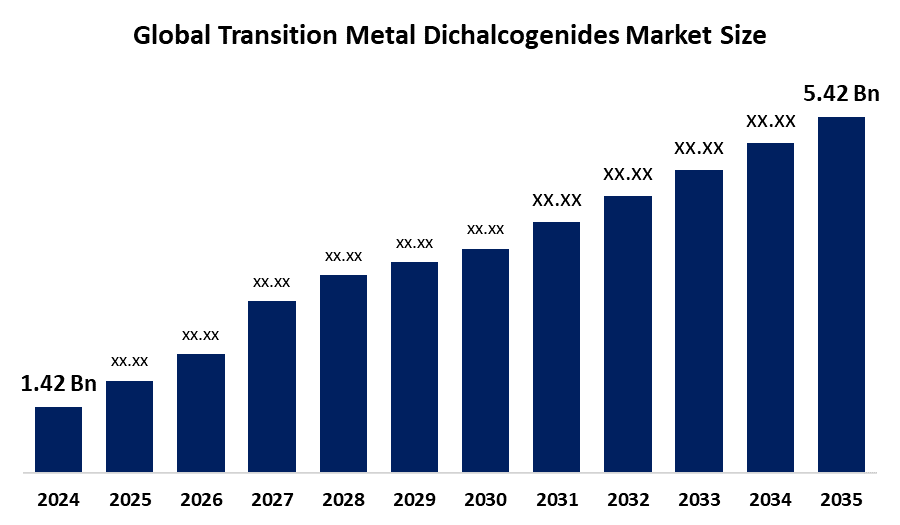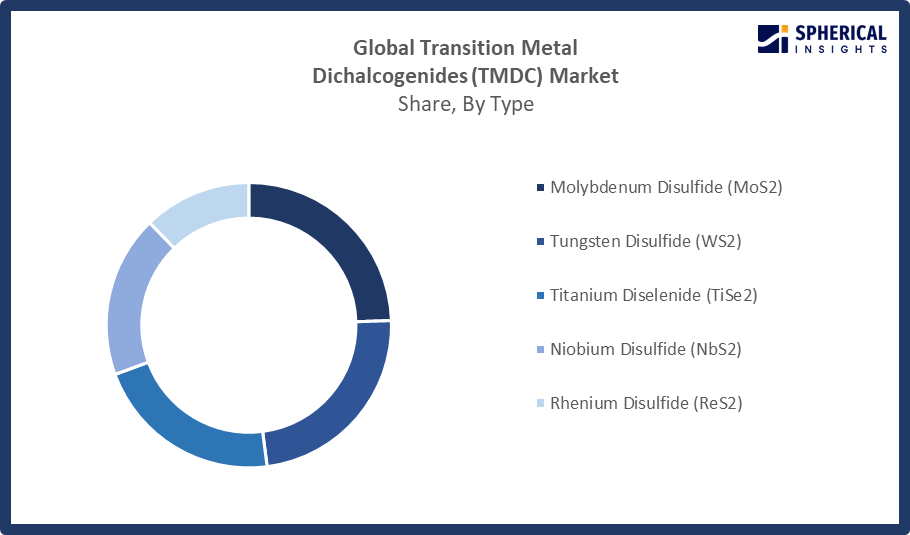Global Transition Metal Dichalcogenides Market Size, Share, and COVID-19 Impact Analysis, By Type (Molybdenum Disulfide (MoS2), Tungsten Disulfide (WS2), Titanium Diselenide (TiSe2), Niobium Disulfide (NbS2), and Rhenium Disulfide (ReS2)), By Application (Electronics, Energy Storage, Optoelectronics, Catalysis, and Coatings), and By Region (North America, Europe, Asia-Pacific, Latin America, Middle East, and Africa), Analysis and Forecast 2025 - 2035
Industry: Chemicals & MaterialsGlobal Transition Metal Dichalcogenides Market Insights Forecasts to 2035
- The Global Transition Metal Dichalcogenides Market Size Was Estimated at USD 1.42 Billion in 2024
- The Market Size is Expected to Grow at a CAGR of around 12.95% from 2025 to 2035
- The Worldwide Transition Metal Dichalcogenides Market Size is Expected to Reach USD 5.42 Billion by 2035
- North America is expected to grow the fastest during the forecast period.

Get more details on this report -
According to a research report published by Spherical Insights and Consulting, the global Transition Metal Dichalcogenides market size was worth around USD 1.42 Billion in 2024 and is predicted to grow to around USD 5.42 Billion by 2035 with a compound annual growth rate (CAGR) of 12.95% from 2025 to 2035. The development of nanotechnology and the rising demand in a variety of high-tech applications are driving the TMDC market's strong rise. The growing need for effective energy storage solutions, the development of the semiconductor sector, and the growing use of optoelectronics are important growth drivers.
Market Overview
The global transition metal dichalcogenides market involves the development, use, and commercialisation of layered materials made up of transition metals and chalcogens for use in electronics, energy storage, catalysis, and optoelectronic devices. The need for next-generation electronics, the growth of artificial intelligence, and the increased use of smartphones. Because of their configurable band gaps and high electron mobility, TMDCs are crucial for photonic devices, flexible electronics, sensors, and transistors. Exfoliation, which creates monolayers that improve electrical and optical qualities and allow for cross-application integration, is a major market driver. For commercial viability, scalable exfoliation methods and advancements in material quality are essential. TMDCs are also used in energy storage devices like supercapacitors and batteries. Given the materials' adaptability and significance in forming future technologies, the market is expected to rise rapidly due to increased research and development. The TMDC market witnessed meaningful developments. The 2D TMDs Conference 2024 exhibited advancements in electronics, photonics, and energy storage; in addition, researchers at the Hefei Institutes found a new superconducting TMDC material. Advances in TMDC-derived nanotubes similarly improved their electro-optical properties, thereby extending their possible use in advanced technology.
The market for energy storage, which includes batteries and supercapacitors, is predicted to reach a valuation of over $100 billion by 2030, according to research by the U.S. Department of Energy (DOE). This will increase demand for TMDC-based materials that can enhance performance in these applications. TMDCs have great potential to enhance the performance of lithium-ion and sodium-ion batteries in the energy storage space. A U.S. Department of Energy research predicts that the need for high-performance batteries will grow rapidly, particularly for grid storage systems and electric vehicles (EVs). This increasing need offers TMDCs a significant chance to play a critical role in supplying these energy storage requirements.
Global Transition Metal Dichalcogenides Market Report Coverage
| Report Coverage | Details |
|---|---|
| Base Year: | 2024 |
| Market Size in 2024: | USD 1.42 Billion |
| Forecast Period: | 2025-2035 |
| Forecast Period CAGR 2025-2035 : | 12.95% |
| 2035 Value Projection: | USD 5.42 Billion |
| Historical Data for: | 2020-2023 |
| No. of Pages: | 240 |
| Tables, Charts & Figures: | 122 |
| Segments covered: | By Type, By Application and By Region |
| Companies covered:: | Rose Mill Co., EdgeTech Industries, ALB Materials, Inc., Skyspring Nanomaterials, Inc., American Elements, Atlantic Equipment Engineers, Lower Friction Co., Exploiter Molybdenum, Noah Chemicals, Denka Corporation, H.C. Starck, Inc., Treibacher Industrieholding GmbH, 3M Company, Dow, Others, and |
| Pitfalls & Challenges: | Covid 19 Impact Challanges, Future, Growth and Analysis |
Get more details on this report -
Driving Factors
The TMDC market presents significant prospects for expansion in the fields of energy storage, flexible electronics, and advanced semiconductors. Because of their high charge mobility and light-matter interaction, TMDCS, such as MoS2 and WSZ, improve transistors, sensors, integrated circuits, photodetectors, and solar cells. The market is expanding due to the growing demand for wearable technology, small electronics, electric cars, and renewable energy storage. Further accelerating growth are TMDC-based catalysts for sustainable chemistry and cutting edge energy storage technologies, which establish TMDCS as crucial components for next-generation energy, optoelectronic, and electronic applications.
Market Segmentation
The transition metal dichalcogenides market share is classified into type and application.
- The molybdenum disulfide (MoS2) segment dominated the market in 2024, approximately 24.5% and is projected to grow at a substantial CAGR during the forecast period.
Based on the type, the transition metal dichalcogenides market is divided into molybdenum disulfide (MoS2), tungsten disulfide (WS2), titanium diselenide (TiSe2), niobium disulfide (NbS2), and rhenium disulfide (ReS2). Among these, the molybdenum disulfide (MoS2) segment dominated the market in 2024 and is projected to grow at a substantial CAGR during the forecast period. It has extraordinary mechanical, optical, and electrical properties. MoS2 is especially advantageous for numerous applications, such as transistors, sensors, photodetectors, and energy storage devices, owing to its large electron mobility, adjustable band gap, and improved R and D investment. Its versatility in semiconductors, in addition to flexible electronics, has strengthened its market position and contributed to the accelerated adoption of applications in the fields of optoelectronics, electronics, and nanotechnology.

Get more details on this report -
Report Coverage
This research report categorizes the transition metal dichalcogenides market based on various segments and regions, forecasts revenue growth, and analyzes trends in each submarket. The report analyses the key growth drivers, opportunities, and challenges influencing the transition metal dichalcogenides market. Recent market developmens and competitive strategies such as expansion, type launch, development, partnership, merger, and acquisition, have been included to draw the competitive landscape in the market. The report strategically identifies and profiles the key market players and analyses their core competencies in each sub-segment of the transition metal dichalcogenides market.
- The electronics segment accounted for the largest share in 2024, approximately 31.4% and is anticipated to grow at a significant CAGR during the forecast period.
Based on the application, the transition metal dichalcogenides market is divided into electronics, energy storage, optoelectronics, catalysis, and coatings. Among these, the electronics segment accounted for the largest share in 2024 and is anticipated to grow at a significant CAGR during the forecast period. The need for high-performance semiconductor materials drives the electronics segment's sizable market share. Transistors, sensors, and integrated circuits are using TMDCs more and more because of their special electrical characteristics. It is anticipated that the electronics industrys explosive growth, especially in emerging nations, will fuel demand for TMDCs in this market.
Regional Segment Analysis of the Transition Metal Dichalcogenides Market
- North America (U.S., Canada, Mexico)
- Europe (Germany, France, U.K., Italy, Spain, Rest of Europe)
- Asia-Pacific (China, Japan, India, Rest of APAC)
- South America (Brazil and the Rest of South America)
- The Middle East and Africa (UAE, South Africa, Rest of MEA)
Asia Pacific is anticipated to hold the largest share with approximately 32.1% of the Transition Metal Dichalcogenides market over the predicted timeframe.

Get more details on this report -
North America is expected to grow the fastest market share with approximately 20.5% at a rapid CAGR in the transition metal dichalcogenides market during the forecast period. The need for TMDCs in the semiconductor and energy storage industries is rising, especially in the US. It is anticipated that the regions emphasis on creating cutting-edge materials for electronics and renewable energy sources will propel market expansion. At the forefront of TMDC research, the US market for transition metal dichalcogenides (TMDC) focuses on novel applications in flexible electronics, optoelectronics, and next-generation transistors. A significant role is played by the defence sector, as TMDCs are being investigated for use in sensors, potent lubricants, and small military electronics. Because of its opulent lubrication and adaptability to harsh environments, TMDC content aids the aircraft industry.
Europe is expected to grow at a rapid CAGR in the transition metal dichalcogenides market during the forecast period. The regions emphasis on green chemistry and sustainable technologies is the driver behind the TMDC market. To explore the possibilities of TMDCs across a variety of applications, including optoelectronics and catalysts, countries such as the United Kingdom, France, and Germany are sponsoring research and development programs.
Competitive Analysis:
The report offers the appropriate analysis of the key organizations companies involved within the transition metal dichalcogenides market, along with a comparative evaluation primarily based on their type of offering, business overviews, geographic presence, enterprise strategies, segment market share, and SWOT analysis. The report also provides an elaborative analysis focusing on the current news and developments of the companies, which includes type development, innovations, joint ventures, partnerships, mergers & acquisitions, strategic alliances, and others. This allows for the evaluation of the overall competition within the market.
List of Key Companies
- Rose Mill Co.
- EdgeTech Industries
- ALB Materials, Inc.
- Skyspring Nanomaterials, Inc.
- American Elements
- Atlantic Equipment Engineers
- Lower Friction Co.
- Exploiter Molybdenum
- Noah Chemicals
- Denka Corporation
- H.C. Starck, Inc.
- Treibacher Industrieholding GmbH
- 3M Company
- Dow
- Others
Key Target Audience
- Market Players
- Investors
- End-users
- Government Authorities
- Consulting and Research Firm
- Venture capitalists
- Value-Added Resellers (VARs)
Recent Development
- In May 2025, 2D TMDCs in Photodetectors studies have highlighted the potential of two-dimensional TMDCs in developing high-performance photodetectors, leveraging their exceptional electronic and optoelectronic properties.
- In May 2024, the 2D TMDs Conference was held at the Hong Kong Polytechnic University, this conference focused on the latest developments in the synthesis and application of 2D TMDCs, covering areas like electronics, photonics, and energy storage.
- In January 2024, Superconductivity Discovery Researchers at the Hefei Institutes of Physical Science, Chinese Academy of Sciences, identified a new superconducting material within the TMDC family, potentially revolutionizing electronic applications.
Market Segment
This study forecasts revenue at global, regional, and country levels from 2020 to 2035. Spherical Insights has segmented the transition metal dichalcogenides market based on the below-mentioned segments:
Global Transition Metal Dichalcogenides Market, By Type
- Molybdenum Disulfide (MoS2)
- Tungsten Disulfide (WS2)
- Titanium Diselenide (TiSe2)
- Niobium Disulfide (NbS2)
- Rhenium Disulfide (ReS2)
Global Transition Metal Dichalcogenides Market, By Application
- Electronics
- Energy Storage
- Optoelectronics
- Catalysis
- Coatings
Global Transition Metal Dichalcogenides Market, By Regional Analysis
- North America
- US
- Canada
- Mexico
- Europe
- Germany
- UK
- France
- Italy
- Spain
- Russia
- Rest of Europe
- Asia Pacific
- China
- Japan
- India
- South Korea
- Australia
- Rest of Asia Pacific
- South America
- Brazil
- Argentina
- Rest of South America
- Middle East & Africa
- UAE
- Saudi Arabia
- Qatar
- South Africa
- Rest of the Middle East & Africa
Frequently Asked Questions (FAQ)
-
1. What is the CAGR of the Transition Metal Dichalcogenides market over the forecast period?The global Transition Metal Dichalcogenides market is projected to expand at a CAGR of 12.95% during the forecast period.
-
2. What is the market size of the Transition Metal Dichalcogenides market?The global Transition Metal Dichalcogenides market size is expected to grow from USD 1.42 Billion in 2024 to USD 5.42 Billion by 2035, at a CAGR of 12.95% during the forecast period 2025-2035.
-
3. Which region holds the largest share of the Transition Metal Dichalcogenides market?Asia Pacific is anticipated to hold the largest share of the Transition Metal Dichalcogenides market over the predicted timeframe.
-
4. Who are the top 10 companies operating in the global Transition Metal Dichalcogenides market?Rose Mill Co., EdgeTech Industries, ALB Materials, Inc., Skyspring Nanomaterials, Inc., American Elements, Atlantic Equipment Engineers, Lower Friction Co., Exploiter Molybdenum, Noah Chemicals, and Denka Corporation, and Others.
-
5. What factors are driving the growth of the Transition Metal Dichalcogenides market?The growing need for flexible electronics, energy storage solutions, and sophisticated semiconductors is propelling the market for transition metal dichalcogenides (TMDCs). Their distinct mechanical, optical, and electrical characteristics improve batteries, sensors, and transistors. Through innovation and technical breakthroughs, expanding applications in AI, IoT, and renewable energy further accelerate market growth.
-
6. What are the market trends in the Transition Metal Dichalcogenides market?The growing use of 2D materials for electronics, flexible and wearable technology, and energy storage applications is one of the major developments in the market for transition metal dichalcogenides (TMDCs). Research on nanotechnology, catalysis, and superconductivity, as well as rising R&D expenditures, are spurring innovation and growing TMDC commercialisation in a variety of sectors.
-
7. What are the main challenges restricting wider adoption of the Transition Metal Dichalcogenides market?The main obstacles to widespread commercialisation and adoption in price-sensitive applications like consumer electronics include high manufacturing costs, the limited scalability of high-quality monolayer synthesis, and stability problems under environmental conditions.
Need help to buy this report?